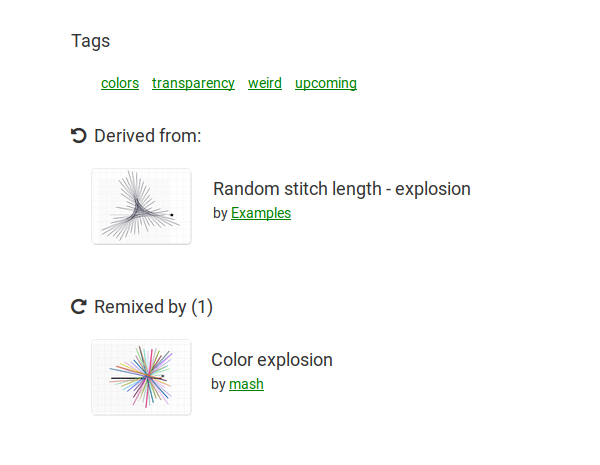What's new?
Dec 19, 2025
Now released: TurtleStitch 2.11.0
This a long-awaited re-sync with the base Snap! - now in version 11 - inheriting its updates and new features. Aside from this Snap! upgrade and some few bug fixes the most notable changes are in the API backend (also syncing to the current Snap! version) and user interface:
- The Programming environment now opens up in full screen mode, eliminating the platforms navigation bar (which confused some users, also it gives more space). Login, logout etc. can be done from within
- Shared projects (that is non-private projects that are accessible to other users) now can also be distinguished between published and unpublished, whereas unpublished projects can be accessed by all users you share the link with, but will not appear in listings and searches
Nov 8, 2024
Relaunch of the Platform!
Turtlestitch.org now runs on TurtleNest - a complete rewrite of the cloud system and web platform. What's new - aside from the big changes such as the fresh layout and better maintanable backend?
- Hashtags - Use hashtags in your project notes
- Semantic search
- Show similar projects in project's detail view
- Upload custom avatar images
- Upload more project images
- Sign in via external accounts (Google, GitHub)
- Sign in with you email or username
- Supports both the TurtleStitch/BeetleCloud legacy API as well as current Snap! API (for the upcoming extenstion)
- Make - the new blog: Ideas and methods for crafting tangible objects
And of course there is a ton of minor fixes and improvements.
Please also make
sure you read the updated Terms of Services and Privacy Policy.
We hope you like it!
Happy Stitching! 🐢
Jul 18, 2024
Now released: TurtleStitch 2.7.18 - "Funny Fish"
- bug fix release
- TurtleStitch now speaks French!
May 11, 2023
Now released: TurtleStitch 2.7.16 - "Olot Opposum"
- faster project list loading
- app check and warning on loading projects created outside of turtlestitch works (again)
- hide blocks fix
- value checks for infinity on various drawing block's inputs
- fixes and updates for geometry library (by Simon), proxied url loader, color changes, ...
and more
Mar 3, 2023
Planned Server Maintainance, Sat March, 4th.
We plan to conduct server maintainance and upgrades. It is to be expect that there will be short down times on Saturday, March 4th afternoon (European timezone). For those who depend on the use of the platform, it is recommended to temporarily switch to our test platform:
- https://dev.turtlestitch.org/ or to use
- the offline version (https://turtlestitch.org/page/offlineuse).
Reporting and help
You can help us to reduce the probability of producing bugs by testing projects in the current beta version:
https://www.turtlestitch.org/beta
In order to do that, open projects in the project's description page and choose to open them with the link on the right side of the "Share" button: "Open in running beta (could be unstable!)"
Example of a projects description page: https://www.turtlestitch.org/users/cynthiasolomon/projects/week22
Bug Reports:
Send reports either to bugs@turtlestitch.org or via https://github.com/backface/turtlestitch/issues
Aug 2, 2022
Now released: TurtleStitch 2.7.7 - "Heidelberg Hedgehog"
- Upgrade to Snap 7 inheriting new Snap! features (scenes are currently not supported by TurtleStitch). Be aware that projects saved with this version can't be loaded into older versions of TurtleStitch!
- as usual: a few bug fixes
- TurtleCloud introduces group mode. If you are an educator who wants to use it, get in touch with us for necessary permissions.
- Remember: If you have weird issues, please make sure to do a full cache reload. Also, if needed you find the old(er) version here.
Mar 14, 2022
Now released: TurtleStitch 2.7.4
- New feature: Import Images (as data/lists or stage background)
- New blocks: Arc Blocks
Dec 14, 2021
Now released: TurtleStitch 2.7 - "Mont Real"
- Upgrade to Snap 6 series (6.9) inheriting all the new Snap features
- includes several bug fixes most notable in EXP export for Bernina machines, updated translations, ...
- New features include DXF export, new blocks (report random position, goto random position, etc.), and updated libraries (thx SimonMong!)
- Troubleshooting: If you experience a blank screen when you run it, make a "force chache reload". There are different shortcuts depending on your operating system or browser. Tell us about your experience here.
- The old version is still available under: https://www.turtlestitch.org/old
Jul 18, 2020
Now released: TurtleStitch 2.6 - "Berkley Beaver"
- Upgrade to Snap 5 series (5.4.5) inheriting new Snap features (drag and drop text and JSON files, official offline support, etc...)
- several bug fixes
- new translations (Chinese, Catalan, Dutch)
Apr 12, 2019
Now released: TurtleStitch 2.5 - "The Whizzy Needle"
Getting Started
Andrea gives you a quick introduction via screencast:
The Whizzy Needle
Whereas the first two releases "Amsterdam" (1.0) and "Bordeaux" (2.0) were mostly proof-of-concept and prototype releases, with the second version being a complete rework of the first, the new release "Whizzy needle" does not introduce major background changes but adds a lot of improvements and significant changes in user interface and production quality.
In short, there finally is - amongst others - color support, font support, a new embroidery category with stitch types, PNG export, and, of course, a lot of bug fixes (having access to a professional machine really helped in finding all the quirks in the embroidery file encoding process), performance optimizations and UI enhancements (such as the X-Ray density visualization and more).
On the platform side, we added tagging support, share buttons, the display of the remix history and minor UI tweaks.
Our community of users grew surprisingly fast and it turned out there are two major use cases for TurtleStitch:
-
The first one, and what was intended from the very beginning as reflected by the project name, is of course in creating embroidery patterns.
-
The second one is in creating vector graphics (SVG) - be it for laser cutters, engravers, for print or for screen.
It was always possible to export SVG files from the very beginning - embroidery patterns are vector graphics after all - but, honestly, its support was a bit clumsy in the early days. Nevertheless, our users picked it up and used it to create designs they then fed to laser cutters or plotters, I myself started using it to create quick sketches and prototypes for generative (design) elements.
The new release takes the distinctive use cases into account by re-organizing the categories: There is a new category "embroidery" that holds all the blocks dealing with embroidery related functionality, the old "pen" category has the blocks that only makes sense for SVG generation and a new "color" category includes mostly new blocks that deal with colors and can be used for both.

If you are coming from an old version of TurtleStitch, the first thing you might notice is that the "move steps in/by" blocks are gone - at least from the block selection. They still exist in the background for compatibility reasons (to keep old projects running), but with "Whizzy Needle", we introduce a new concept of stitch segmentation: Instead of assigning segment length or number to variations of "move" or "goto" blocks, you now define a running stitch once (or any other stitch type), and it will be applied to all commands that follow in your script (or until you reset or choose another stitch type). Take a look into the "embroidery" category or read more on stitch types below.
Embroidery category / Stitch types
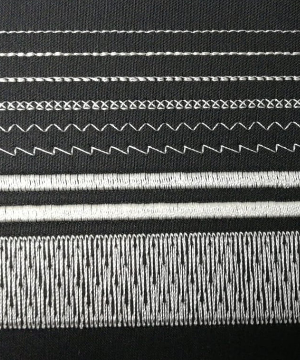
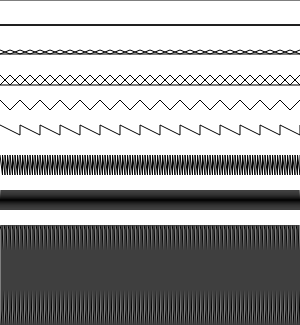
The Embroidery category has all embroidery-specific blocks and introduces some common stitch types: running stitch, a triple run (bean) stitch, cross stitch, zigzag and z-stitch as well as satin and tatami stitch. All of these stitch types have a few options and you add them once to your script, it will then be applied to all move or goto blocks that follow or until you define a new stitch type or reset them either with "reset" or "stop running".
Instead of using move 100 by 10 commands as in the old version of TurtleStitch, you would now use a running stitch by 10 and then simply move 100. This will create a line with a distance of 100 steps segmented into ten stitches with a length of 10 steps each. All of these stitch types will auto adjust, that means if you have defined a running stitch by 10 but then move 98 and not 100 it will adjust the segment length to 9.8, trying to figure out the closed length possible that is a divider of the distance to be moved without remainder (Should there be remainder, it will be drawn as a simple line).

Most of the stitch types have an option for the length of a segment, some of them also for the width of the pattern. Density in zigzag and z-stitch is the length of one full cycle, one full zigzag (or "wavelength"). All of them have an option for "center" true/false that relates to the turtle and the width of the stitch type pattern, whether the turtle is positioned in the center or on top of the stitch pattern.
-
triple run is a stitch that goes back and forth (also known as bean stitch).On the display, it looks the same as a single line, but it will be thicker when stitched (as each line segment is stitched three times)
-
cross stitch is a version of the cross stitch with a variable length and width.

- zigzag creates a zigzagged line

- z-stitch makes a zigzag line as well, but with a different pattern.

- satin stitch is a very dense zigzag.

- tatami stitch is a fill stitch. It draws dense lines next to each other and it is segmented itself into smaller stitches again (with the interval being what length is for the running stitch) and with a variable offset so that variable fill patterns can be created.
If all of this sounds strange to you, there also is a good intro to various stitch types on the EduTechWiki
To define jump stitches we now recommend to use jump on / jump off (these are basically renamed versions of pen up / pen down from the pen category)

Pen category / SVG support
You don't need this category anymore if you create embroidery patterns. There are some news for those who create vector graphics though: We have new blocks to change opacity and pen size and these settings will also be exported as stroke styles into SVG and PNG files.
SVG files will encode the lines strings with round line caps.
You can now export to PNG case you need an embroidery preview image or a rasterized rendering of your stage (find it in the menu)
Color support
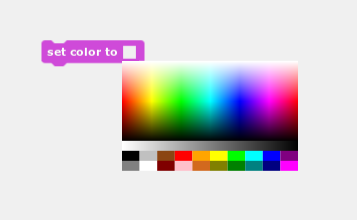
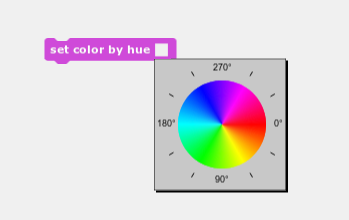
Color support is now functional in all exported file formats depending on the format's limitations. DST and EXP embroidery files only encode color change events but do not include further information about the colors itself (We might look into other formats in the future).
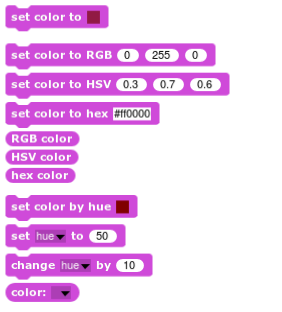
You'll also find a new export option "ignore colors during export", in case you want to export a multicolor pattern as a single color one.
Font support
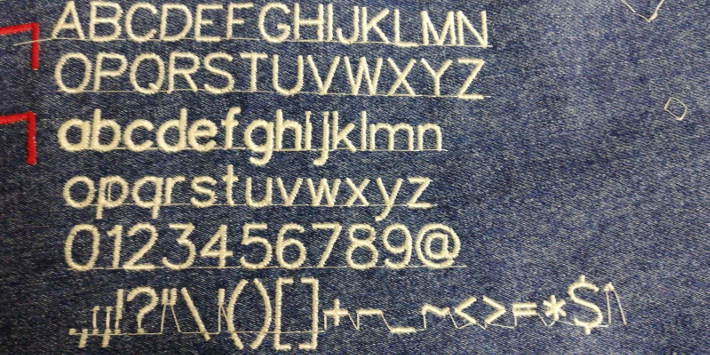
TurtleStitch got its own font! It's an adaption of A.V. Hersheys's Simplex vector font and designed to be flexible. It defines a movement pattern that minimizes jump stitches and can be stitched in various ways with a running stitch or stitch pattern of your choice. You can render the text with a triple stitch, or a satin stitch - it's up to you, just define your stitch type before you write the text with the draw text block. If no stitch type is defined, the text is drawn according to Hersheys's original font data.

Turtle menu
All viewing options (show/hide grid, inch/millimeters, etc.) moved to a new "turtle" settings menu. These settings are now persistent (stored in your browser's local storage).
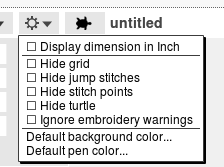
New options include a setting for preferred background color and default pen color.
Other new blocks
Operators: PI
Move: point towards x y
Sensing: proxied URL (requests an URL via a CORS proxy running on turtlestitch.org)
Other: zoom to fit
Pen: pen size (reporter), set opacity to, change opacity by, opacity (reporter)
X-Ray Density visualization
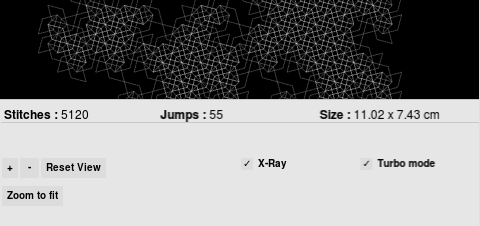
The new X-Ray like visualization option helps you to judge and debug thread density of your design by rendering the stitches in semi-transparent lines. If parts of the pattern turn very white, it's likely too dense!

Tagging & Remix history
On a project's initial save into the cloud you now have the option to tag them with tags of your choice. Tags for existing projects can be edited via the cloud platform.
